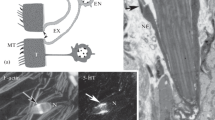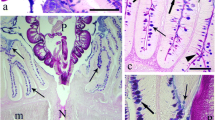Summary
-
1.
The plexus discovered by Hiller (1939) in the cystid wall of Electra pilosa by methylen blue staining has also been identified in Electra posidoniae.
Hiller's plexus, which can be easily discriminated from the peritoneal lining, does not extend over the whole zoecium surface like the diffuse network already known in the wall of two Ctenostomata; it appears in each zoecium as a single fiber running around the basal border of interzoecial partitions, connected by short anastomosis through each pore-chamber with the similar peripheral thread of neighbouring zoecia and with the polypide ganglion by twin nerves following the tentacular sheath. The nervous centers of all the individuals in the zoarium are thus united, and morphological data support the hypothesis of an actual cystidian nervous structure liable to convey general interzoecial sensitivity in Cheilostomata Anasca.
-
2.
A peripheral fiber is also stained by methylen blue in the autozoecium and in the ovicell of the Ascan Haplopoma impressum but its homology with the “plexus” in Electridae can not be asserted as no conspicuous link with the central nervous system is to be seen.
-
3.
Nerves leading to the peripheral parietal fiber in Electra pilosa originate from the big twin cells of the anterior part of the ganglion; the twin nerves arising from the posterior giant neurons run along the tentacular sheath toward the vestibule and the frontal area, and join up halfway with the middle branches of the motor trifid nerves issuing from another pair of posterior ganglion cells. A general description of the origin and connections of the different nerves leads to a diagram of the main nervous pathways.
Résumé
-
1.
Le réseau que Hiller (1939) avait mis en évidence par le bleu de méthylène dans la paroi du cystide chez Electra pilosa a été retrouvé par la même coloration, identique à la description de l'auteur, chez cette même espèce et chez Electra posidoniae.
Ce réseau, distinct du reticulum péritonéal et différent du plexus pariétal superficiel et diffus connu chez deux Cténostomes, est constitué dans chaque loge par un filament périphérique unique qui suit la base des cloisons interzoéciales, relié au filament semblable des loges voisines par des ponts qui traversent les plaques de communication interzoéciales, et au ganglion du polypide par deux nerfs qui suivent la gaine tentaculaire.
Le ≪plexus≫ de Hiller dont l'interprétation comme une forme plausible de l'innervation de la paroi chez les Anascophores s'appuie sur des arguments d'ordre anatomique, est ainsi susceptible d'établir de proche en proche une connexion générale des centres nerveux des unités du zoarium.
-
2.
Un filament péricystidien de même parcours a été coloré par la même technique chez le Chilostome Ascophore Haplopoma impressum; mais son homologie avec le ≪plexus≫ des Electridae n'a pas été établie avec certitude.
-
3.
Le ≪plexus≫ pariétal des Electridae reçoit les prolongements des volumineuses cellules ganglionnaires paires du secteur antérieur du ganglion; les nerfs issus des cellules ganglionnaires paires géantes du secteur postérieur se dirigent vers l'orifice et vers l'area frontale, rejoints à mi-trajet par les nerfs moteurs dits ≪trifides≫, provenant de cellules plus internes de la même région. La description détaillée de l'origine et des connexions des principaux nerfs conduit à une discussion générale de la signification des grands axes du réseau nerveux.
Similar content being viewed by others
Bibliographie
Alexandrowicz, J. S.: Muscle receptor organs in the abdomen of Homarus vulgaris and Palinurus vulgaris. Quart. micr. Sci. 92, 163–199 (1951).
: Notes in the nervous system in the Stomatopoda. Publ. Staz. Zool. Napoli 25, 94–111 (1951).
Bronstein, G.: Etude du système nerveux de quelques Bryozoaires Gymnolémides. Trav. St. Biol. Roscoff 15, 155–174 (1937).
Bullock, T. H., and G. A. Horridge: Structure and function in the nervous system of Invertebrates, vol. I: Mechanisms and principles; lower phyla, pp. 789. San Francisco and London: Freeman & Co. 1965.
Cook, P. L.: Observation on live Lunulitiform zoaria of Polyzoa. Cah. Biol. Mar. Roscoff 4, 407–413 (1963).
Gewerzhagen, A.: Beiträge zur Kenntnis der Bryozoen. Z. wiss. Zool. 107, 3–345 (1913).
Graupner, H.: Zur Kenntnis der feineren Anatomie der Bryozoen. Z. wiss. Zool. 136, 38–97 (1930).
Hiller, S.: The so-called nervous colonial system in Bryozoa. Nature (Lond.) 143, 1069–1070 (1939).
Hilton, W. A.: A study of the movements of Ectoproctan Bryozoan. Trans. Amer. micr. Soc., Menasha 42, 135–143 (1923).
Marcus, E.: Beobachtungen und Versuche am lebenden Meeresbryozoen. Zool. Jb., Abt. System. Ökol. u. Geogr. 52 (1), 1–102 (1926).
Marcus E.: Über Lophopus cristallinus (Pallas). Zool. Jb., Abt. Anat. u. Ontog. 58, 506–606 (1934).
Retzius, G.: Das sensible Nervensystem der Bryozoen. Biol. Untersuch. 12, 49–54 (1905).
Ryland, J. S.: The species of Haplopoma (Polyzoa), Sarsia 10, 9–18 (1963).
Silberman, S.: Untersuchungen über den feineren Bau von Alcyonidium mytili. Arch. Naturg. (Berl.), 72 (1) 265–310 (1906).
Silen, L.: On the formation of the interzoidial communications of the Bryozoa. Zool. Bidr. (Uppsala) 22, 433–488 (1944).
: On the mobility of entire zoids in Bryozoa. Acta zool. (Stockh.), 31, 349–386 (1950).
: On the nervous system of Phoronis. Ark. Zool. (Stockh.), 6 (1) 1–39 (1954).
Author information
Authors and Affiliations
Rights and permissions
About this article
Cite this article
Lutaud, G. Le «plexus» pariétal de Hiller et la coloration du système nerveux par le bleu de méthylène chez quelques Bryozoaires Chilostomes. Z. Zellforsch. 99, 302–314 (1969). https://doi.org/10.1007/BF00342229
Received:
Issue Date:
DOI: https://doi.org/10.1007/BF00342229




